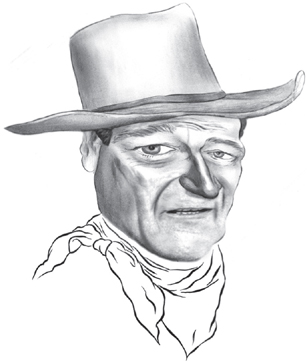

“Tequila makes your head hurt. Not from your hangover. From falling over and hitting your head.”
Strong and silent onscreen, hawkish and ultraconservative off, John Wayne transcended cinema so thoroughly he became the ultimate symbol (for better or worse) of American ideals and values. Born Marion Morrison, he adopted the nickname “Duke” as a kid. He played football for the USC Trojans until an injury ended his athletic career. After floundering in B-movies, Westerns, and serials, John Ford made him a star with his breakthrough role in Stagecoach (1939). Wayne and Ford went on to work together more than twenty times over the years, in such enduring classics as She Wore a Yellow Ribbon (1949), The Searchers (1956), and The Man Who Shot Liberty Valance (1962). Wayne won his only Oscar as Best Actor—after a prior nomination for Sands of Iwo Jima (1949)—for his portrayal of the flawed Rooster Cogburn in True Grit (1969). (Jeff Bridges would be nominated for an Oscar in the same role more than thirty years later.) Wayne is credited for directing two films over the course of his career: The Alamo (1960), which was nominated for Best Picture, and The Green Berets (1968), which came out unabashedly in favor of the Vietnam War. His humility and honesty earned him the begrudging respect of even his enemies, and he remains the most towering single image of an American ever produced by Hollywood.
1. MEET JOHN WAYNE. 2. Go to Disneyland. Those were the two items on Nikita Khrushchev’s wish list during his 1959 visit to Los Angeles. The only two. So it came to pass that John Wayne allegedly stood at a private bar, tossing back tequila and vodka with Soviet premier Nikita Khrushchev. It was, to put it mildly, an unlikely scenario: one of America’s most famous anti-Communists chumming around with one of Communism’s most prominent leaders. When President Eisenhower first proposed the meeting, Wayne initially said yes solely out of respect for the president. But then, on a personal level, he did have a motive all his own—a certain question that had been gnawing away at him. And there at the bar, with the aid of an interpreter and who knows how many shots, he popped it: “So, Nikita”—that’s not actually how he brought it up, but let’s pretend—“exactly why are your people trying to kill me?”
You see, Wayne believed that the Communists had been trying to murder him for over a decade. In 1951 two Russian hit men had supposedly tried to gun him down outside his office at Warner Bros. (Federal agents, acting on a tip, foiled the plan.) Another time, in 1955, a group of American Communists in Burbank had their plot to kill Duke broken up by a group of stuntmen who’d caught wind of the operation. And if Wayne was to be believed, these instances were the direct result of orders issued by Khrushchev’s predecessor, Josef Stalin.
As for the two attempts on Wayne’s life, [Khrushchev] didn’t know anything about those. Perhaps they were Stalin loyalists beyond his or anyone’s control. Perhaps they were followers of Mao Tse-tung, who had also been involved in Stalin’s plans. Regardless, Wayne shouldn’t let his guard down.
In 1983 Orson Welles (by no means a kindred spirit of Wayne politically, though he liked the man) corroborated the Stalin story. The tale Welles told is long and convoluted (and again, the product of hearsay), but the essence is this: In 1949, Stalin had sent a movie director, Sergei Gerasimov, to an international conference in New York with explicit instructions to denounce Hollywood’s lack of morals and to promote Stalinism. While there, Gerasimov learned about Wayne—at that time the president of the Motion Picture Alliance for the Preservation of American Ideals. When Gerasimov returned to the Soviet Union with news of this man’s aims and his power, Stalin responded as though America had “invented some new secret weapon,” a weapon he intended to neutralize.
Khrushchev didn’t deny Stalin’s intent. He said it was a product of Stalin’s “last five mad years,” and that the order had long been rescinded. As for the two attempts on Wayne’s life, he didn’t know anything about those. Perhaps they were Stalin loyalists beyond his or anyone’s control. Perhaps they were followers of Mao Tse-tung, who had also been involved in Stalin’s plans. Regardless, Wayne shouldn’t let his guard down.
Three months after their drinking session, a large wooden crate marked CCCP arrived at Wayne’s offices. Inside, packed in straw, were several cases of premium Russian vodka, along with a note that said, “Duke. Merry Christmas. Nikita.” Wayne quickly returned Khrushchev’s gesture, sending the Soviet leader a few cases of Sauza Conmemorativo with a note of his own: “Nikita. Thanks. Duke.”
And so the story ends, with one small caveat: Nobody knows how much of it is true. But then, as the line goes, from the Wayne classic The Man Who Shot Liberty Valance, “When the legend becomes fact, print the legend.” And if there is a larger truth to be had, maybe it is this—John Wayne liked drinking more than he hated Communists.